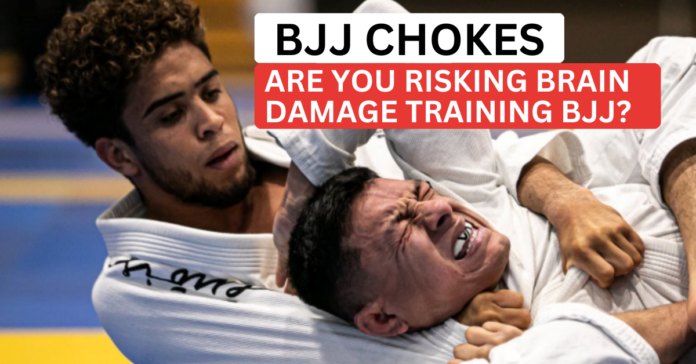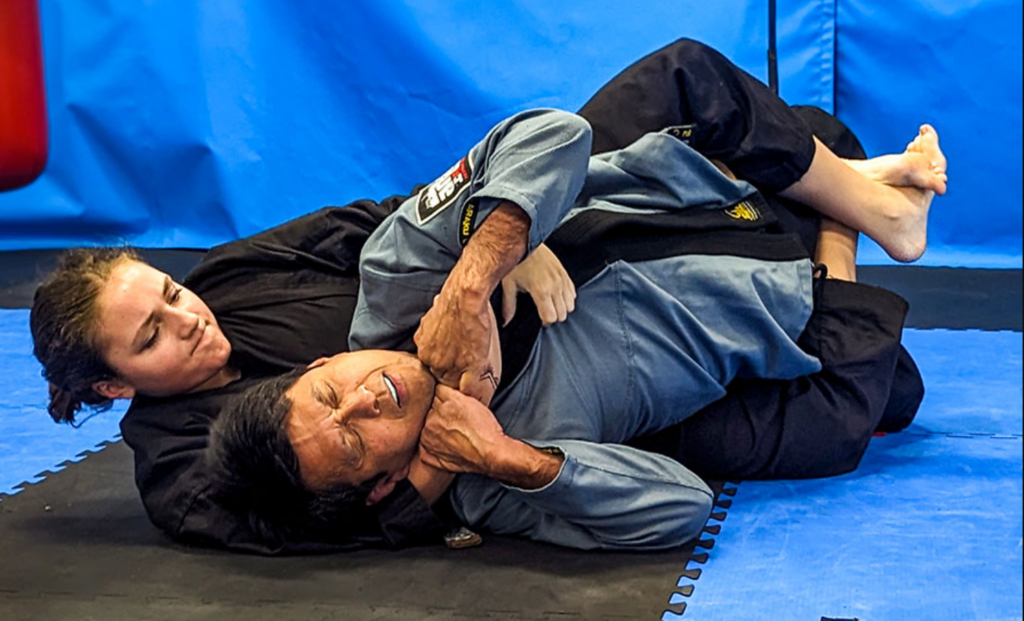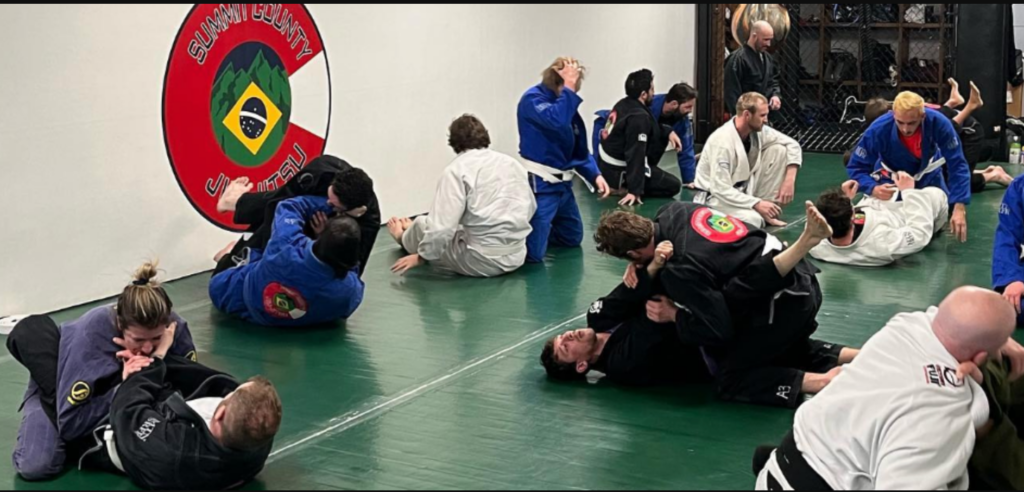
Brazilian Jiu-Jitsu is a combat sport known for its strategic grappling techniques and effective submissions. Among these techniques, chokes play a pivotal role, often becoming the deciding factor in a match.
While mastering chokes is essential for any BJJ practitioner, it is equally important to understand the potential risks associated with their use. One of the most concerning risks is brain damage from BJJ chokes, a topic that has garnered increasing attention within the BJJ community.
An Overview of BJJ Chokes
In Brazilian Jiu-Jitsu, chokes are fundamental techniques used to control and submit opponents. These chokes are categorized mainly into two types: blood chokes and air chokes.
Blood Chokes vs. Air Chokes
Blood chokes, also known as vascular chokes, compress the carotid arteries, reducing blood flow to the brain. This often results in a quick and effective submission. Common examples of blood chokes in BJJ are the rear-naked choke and the triangle choke.
Air chokes, on the other hand, obstruct the airways, making it difficult for the opponent to breathe. While effective, air chokes are less commonly used due to the increased risk of injury. The Guillotine is one of the most common examples, as is the Ezekiel choke.
How BJJ Chokes Affect the Brain
Understanding how chokes impact the brain is key to recognizing the potential risks involved. When performing a blood choke, the practitioner applies pressure to the carotid arteries located on either side of the neck. This pressure reduces the amount of blood and oxygen reaching the brain, leading to a temporary loss of consciousness if held for too long.
Short-term vs. Long-term Effects
In the short term, the effects of chokes are generally reversible. Once the pressure is released, blood flow and oxygen supply to the brain resume, and consciousness is typically restored within seconds.
However, if the choke is held for an extended period, it can lead to more severe consequences. Long-term exposure to repeated chokes can potentially result in brain damage.
This damage can manifest in various ways, such as cognitive impairment, memory loss, and other neurological issues. It’s essential for practitioners to be aware of these risks and take appropriate precautions.
Symptoms of Brain Damage
Repeated exposure to chokes, especially when performed incorrectly or with excessive force, can increase the risk of chronic brain damage. This can manifest as cognitive decline, memory loss, and other neurological problems:
- Persistent headaches
- Dizziness or balance issues
- Memory problems or confusion
- Changes in behavior or mood
- Difficulty concentrating
Recognizing the warning signs of brain damage is crucial for timely intervention
Scientific Research on Brain Damage from BJJ Chokes
A thorough understanding of the risks associated with BJJ chokes requires examining scientific research and expert opinions. Let’s explore what studies and medical professionals have to say about the impact of these techniques on brain health.
Summary of Key Studies
Several studies have been conducted to assess the effects of chokes on the brain. Research indicates that while short-term effects are generally reversible, prolonged or repeated exposure can pose significant risks.
For example, a study published in the journal “Brain Injury” found that repeated chokes can lead to cumulative brain damage by way of anoxia, potentially resulting in cognitive impairment and other neurological issues.
Real-life Case Studies and Reported Incidents
There have been reported incidents where practitioners have experienced severe consequences from chokes.
For instance, three is the example of a Russian BJj practitioner who suffered a stroke and has been trying to figure out how to live after the fact. Luckily he is alive, but such cases highlight the need for increased awareness and caution among BJJ practitioners:
Precautionary Measures in BJJ Training
Ensuring the safety of practitioners during BJJ training is paramount, especially when it comes to techniques involving chokes. By taking appropriate precautions, we can minimize the risk of brain damage while maintaining the effectiveness of training sessions
Tips for Practitioners to Minimize Risk
- Tap Early and Often: Practitioners should not hesitate to tap out when they feel uncomfortable or at risk. Tapping early can prevent serious injuries and ensure a safe training experience.
- Avoid Excessive Pressure: Applying too much pressure during a choke can increase the risk of brain damage. Practitioners should aim to use the minimum amount of force necessary to achieve a submission.
- Communicate with Training Partners: Open communication with training partners can help prevent accidents. Practitioners should inform their partners if they feel uncomfortable or need to adjust the technique.
- Stay Informed: Keeping up to date with the latest safety guidelines and research on BJJ chokes can help practitioners make informed decisions about their training.
Role of Coaches and Instructors
Coaches and instructors are not only responsible for teaching techniques but also for creating a safe training environment. They should regularly monitor students’ progress, provide feedback, and intervene when necessary to prevent accidents.
In the event of an injury caused by a BJJ choke, determining liability can be complex. Both practitioners and instructors have a responsibility to ensure that techniques are applied safely. Instructors must provide adequate training and supervision, while practitioners must follow safety guidelines and communicate openly with their training partners.
BJJ academies should have clear policies and procedures in place to handle injuries and disputes. This can include waivers, insurance coverage, and a defined protocol for reporting and addressing injuries.
Wrapping Up
Understanding the risks and precautions associated with BJJ chokes is crucial for maintaining a safe and effective training environment. While chokes are a fundamental part of Brazilian Jiu-Jitsu, their potential impact on brain health cannot be overlooked.
By recognizing how chokes affect the brain, reviewing scientific research, and implementing precautionary measures, practitioners can minimize the risk of brain damage. Long-term safety considerations, including regular health monitoring and preventive measures in BJJ academies, are essential for protecting practitioners from the cumulative effects of repeated chokes.
Ultimately, the goal is to balance the benefits and risks of BJJ chokes, promoting a culture of safety and awareness. By staying informed, practicing proper techniques, and prioritizing safety, practitioners can continue to enjoy the many benefits of Brazilian Jiu-Jitsu while minimizing potential harm.
Former UFC Star’s Freak Injury: Penis Fracture from BJJ Training!
Graphic Content – Horror Grappling Injury Leaves Fighter Paralyzed


![Darce Choke Encyclopedia – Origins, Mechanics and Variations [2025] BJJ, choke, Brabo, BJJ Darce Choke, D'arce Choke, Darce BJJ Choke](https://bjj-world.com/wp-content/uploads/2017/11/JungPoirierLeeYahoo-218x150.jpg)













![Slicin’ Calves Mikey Musumeci DVD Review [2025] Slicin' Calves Mikey Musumeci DVD Review](https://bjj-world.com/wp-content/uploads/2025/04/slicin-calves-mikey-musumeci-dvd-review-218x150.png)
![Jiu-Jitsu For Old Guys Guard Retention Bernardo Faria DVD Review [2025] Jiu-Jitsu For Old Guys Guard Retention Bernardo Faria DVD Review](https://bjj-world.com/wp-content/uploads/2025/03/old-guys-guard-retention-bernardo-faria-dvd-review-218x150.png)
![X-Guard Trickery Kyle Sleeman DVD Review [2025] X-Guard Trickery Kyle Sleeman DVD Review](https://bjj-world.com/wp-content/uploads/2025/03/x-guard-trickery-kyle-sleeman-dvd-review-218x150.png)
![Countering with Crab Ride Anthony Budion DVD Review [2025] Countering with Crab Ride Anthony Budion DVD Review](https://bjj-world.com/wp-content/uploads/2025/03/countering-with-crab-ride-anthony-budion-dvd-review-218x150.png)
![Closet Closed Guard Craig Jones DVD Review [2025] Closet Closed Guard Craig Jones DVD Review](https://bjj-world.com/wp-content/uploads/2025/03/closet-closed-guard-craig-jones-dvd-review-218x150.png)
![Just Pass Jay Rodriguez DVD Review [2024] Just Pass Jay Rodriguez DVD Review](https://bjj-world.com/wp-content/uploads/2024/11/just-pass-jay-rodriguez-dvd-review-324x235.png)
![Front Headlock and Turtle Escapes Brian Glick DVD Review [2024] Front Headlock and Turtle Escapes Brian Glick DVD Review](https://bjj-world.com/wp-content/uploads/2024/11/headlock-and-turtle-escapes-brian-glick-dvd-review-100x70.png)
![Higher Tripod Passing Craig Jones DVD Review [2025] Higher Tripod Passing Craig Jones DVD Review](https://bjj-world.com/wp-content/uploads/2025/02/higher-tripod-passing-craig-jones-dvd-review-100x70.png)

![No-Gi Grapplers Guide To Front Headlock Joel Bane DVD Review [2025] No-Gi Grapplers Guide To Front Headlock Joel Bane DVD Review](https://bjj-world.com/wp-content/uploads/2025/03/no-gi-front-headlock-joel-bane-dvd-review-100x70.png)

![Mastering Takedown Prevention Steve Mocco DVD Review [2024] Mastering Takedown Prevention Steve Mocco DVD Review](https://bjj-world.com/wp-content/uploads/2024/11/mastering-takedown-prevention-steve-mocco-dvd-review-100x70.png)
![Foot Sweep the World Dainis Nguyen-Huu DVD Review [2024] Foot Sweep the World Dainis Nguyen-Huu DVD Review](https://bjj-world.com/wp-content/uploads/2024/11/foot-sweep-the-world-dainis-nguyen-huu-dvd-review-100x70.png)
![Systematically Attacking The Crucifix Gordon Ryan DVD Review [2024] Systematically Attacking The Crucifix Gordon Ryan DVD Review](https://bjj-world.com/wp-content/uploads/2024/10/systematically-attacking-the-crucifix-gordon-ryan-dvd-review-100x70.png)



![Breaking Their Guard Mikey Musumeci DVD Review [2025] Breaking Their Guard Mikey Musumeci DVD Review](https://bjj-world.com/wp-content/uploads/2025/02/breaking-their-guard-mikey-musumeci-dvd-review-100x70.png)

![Modern Split Squat Passing Jason Rau DVD Review [2024] Modern Split Squat Passing Jason Rau DVD Review](https://bjj-world.com/wp-content/uploads/2024/11/modern-split-squat-passing-jason-rau-dvd-review-100x70.png)
![Heavy Top Game Fabiano Scherner BJJ DVD Review [2025] Heavy Top Game Fabiano Scherner BJJ DVD Review](https://bjj-world.com/wp-content/uploads/2025/01/heavy-top-game-fabiano-scherner-bjj-dvd-review-100x70.png)
![Charles Allan Price Building Workouts For BJJ DVD Review [2024] Charles Allan Price Building Workouts For BJJ DVD Review](https://bjj-world.com/wp-content/uploads/2024/09/charles-allan-price-building-workouts-for-bjj-review-100x70.png)

![Grappling Takedown Dominance Brandon Ruiz DVD Review [2025] Grappling Takedown Dominance Brandon Ruiz DVD Review](https://bjj-world.com/wp-content/uploads/2025/01/grappling-takedown-dominance-brandon-ruiz-dvd-review-100x70.png)
![Mastering Control From Top Position Trent Hidlay DVD Review [2024] Mastering Control From Top Position Trent Hidlay DVD Review](https://bjj-world.com/wp-content/uploads/2024/11/control-from-top-position-trent-hidlay-dvd-review-100x70.png)
![Special K Guard Neil Melanson DVD Review [2025] Special K Guard Neil Melanson DVD Review](https://bjj-world.com/wp-content/uploads/2025/03/special-k-guard-neil-melanson-dvd-review-100x70.png)
![Miko Hytonen Lapel Chokes From Everywhere DVD Review [2024] Miko Hytonen Lapel Chokes From Everywhere DVD Review](https://bjj-world.com/wp-content/uploads/2024/10/miko-hytonen-lapel-chokes-from-everywhere-dvd-review-100x70.png)
![Power Passing Body Locks Dan Manasoiu DVD Review [2025] Power Passing Body Locks Dan Manasoiu DVD Review](https://bjj-world.com/wp-content/uploads/2025/01/power-passing-body-locks-dan-manasoiu-dvd-review-100x70.png)

![Leg Lock Strategies: Navigating Entanglements Jack Stapleton DVD Review [2024] Leg Lock Strategies: Navigating Entanglements Jack Stapleton DVD Review](https://bjj-world.com/wp-content/uploads/2024/12/navigating-entanglements-jack-stapleton-dvd-review-100x70.png)
![No-Gi Pressure Mastery JT Torres DVD Review [2024] No-Gi Pressure Mastery JT Torres DVD Review](https://bjj-world.com/wp-content/uploads/2024/10/no-gi-pressure-mastery-jt-torres-dvd-review-100x70.png)
![Jeff Higgs Self Defense Guard BJJ DVD Review [2024] Jeff Higgs Self Defense Guard BJJ DVD Review](https://bjj-world.com/wp-content/uploads/2024/09/jeff-higgs-self-defense-guard-bjj-dvd-review-100x70.png)